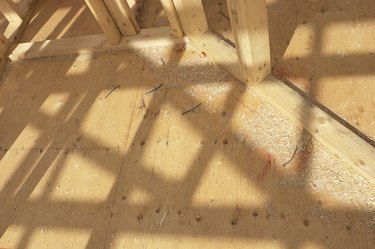Things You'll Need
Plywood
Wood glue
Wood screws
Drill
Skill saw
Tape measure
Carpenter's square

Many people don't bother to glue down their plywood underlayment. Instead, they just screw or nail the boards to the subfloor. This is fine if you're not worried about the long-term durability of your work. To create a surface that will be strong and long lasting and that won't shift or peel up as the building shifts or moisture accumulates, glue your underlayment down to create a more stable base. A plywood underlayment helps to strengthen a subfloor that has some flex or bend to it to make a more stable foundation for your floor.
Step 1
Start with a piece of plywood in the corner of the room farthest from the door. Use your carpenter's square to check the squareness of the board. Not all plywood sheets are perfectly square, but you should try to start with a relatively square one for your first sheet. Leave between a 1/4- to 1/2-inch gap between the boards and the walls so that there is room for expansion. If the subfloor is plywood, orient the underlayment in the opposite orientation of the first layer of plywood. If the subfloor is wood plank, orient the plywood grain at a 90-degree angle to the grain of the planks. On a concrete subfloor, you could choose to orient the plywood in whatever direction works best for you.
Video of the Day
Step 2
Mark out the area the plywood sheet covers with a pencil so you know where to apply the glue without making a mess by putting extra in the areas where you still have to work. After the first few sheets, you will be able to gauge how much space the next sheet of plywood will take up without marking, but when getting started it helps ensure you only apply glue over an area the size of a single sheet of plywood at a time.
Step 3
Apply a layer of glue to the subfloor to which the plywood underlayment is being applied. Read the instructions for the brand of glue that you're using to see how it should be applied, and how thickly. If there are no instructions, apply an even pattern of glue across the entire surface to which the plywood will be glued, ensuring that you lay glue along the edges and liberally throughout the middle. If you want to create a very strong and even hold, use a roller or a brush after you apply the glue to spread it into an even layer that covers the entire surface.
Step 4
Firmly press the plywood sheet into place. This will be easier if two people place the plywood down onto the glue and then press down firmly to help the glue set.
Step 5
Drill a few screws through the plywood into the subfloor to suck the plywood tight while increasing the overall strength of the connection between the underlayment and the underlying material.
Step 6
Repeat this process until the entire room is covered. Stagger the plywood sheets so that your joints don't line up. Start by building across the room from your initial sheet and then cutting a piece to fit with your circular saw when you reach the end of the room. Then, use either a half-sheet or the remainder of your initial cut piece to start the next row.
Step 7
Allow the glue to dry completely according to the manufacturer's specifications before you start to lay any flooring.
Tip
Allow the plywood sheets to sit in the room where they will be installed for at least two days before you install the underlayment. This helps them absorb any moisture or dry out to match the atmospheric conditions of the room.
Warning
Check all instructions and information available for both your flooring system and your plywood underlayment before you start gluing. Some types of plywood underlayment require specific types of glues, while other should only be screwed down. Some flooring systems also recommend not gluing down the underlayment, which should always be taken into consideration before you start installing the plywood.
Video of the Day
- Halex Corporation: Plywood Underlayment: Halex Plywood Underlayment
- Hosking Hardwood: Installing Hardwood Floors Over Different Subfloors
- CanPly: Plywood Underlayment
- Plum Creek: Proper Selection and Installation of APA Plywod Underlayment
- UMass Amherst: Building and Construction Technology
- HardwoodInstaller.com: Proper Subfloors for Hardwood Flooring
- Floor Covering Installer: Tips for Selecting and Installing Plywood Underlayment